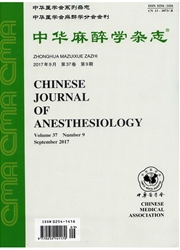

 中文摘要:
中文摘要:
目的探讨p38丝裂原活化蛋白激酶(p38 MAPK)在全脑缺血再灌注损伤大鼠海马神经元DNA修复中的作用。方法清洁级雄性SD大鼠108只,采用四血管阻断法建立大鼠全脑缺血再灌注模型,随机分为3组(n=36):假手术组(S组)仅暴露双侧颈总动脉和椎动脉;缺血再灌注组(IR组)侧脑室注射1%DMSO溶液5μl,30min后行全脑缺血再灌注;p38MAPK抑制剂SB203580干预组(SB组)侧脑室注射SB203580溶液5μl(溶于1%DMSO溶液),30min后行全脑缺血再灌注。分别于再灌注2、6、12、24、48和72h时各组处死6只大鼠,提取海马组织观察神经元病理学结果,计算神经元凋亡指数(AI),测定磷酸化的p38MAPK蛋白及Ku70蛋白表达水平。结果与S组比较,IR组和SB组各时点AI升高,p-p38 MAPK蛋白表达上调,p-Ku70蛋白表达下调(P〈0.05或0.01),病理损伤明显;与IR组比较,SB组各时点AI降低,p-p38MAPK蛋白表达下调,p-Ku70蛋白表达上调(P〈0.01),病理损伤程度减轻。结论p38MAPK可能通过下调DNA修复酶KuT0蛋白的表达,使海马神经元DNA修复功能受损,导致神经元凋亡,参与全脑缺血再灌注损伤。
 英文摘要:
英文摘要:
Objective To investigate the role of p38 mitogen-activated protein kinase (MAPK) in the DNA repair in hippocampus in a rat model of global cerebral ischemia-reperfusion (I/R). Methods One hundred and eight male 55-65 day old SD rats weighing 280-320 g were divided into 3 groups ( n = 36 each) : group Ⅰ sham operation (S), group Ⅱ I/R and group Ⅲ SB203580 + I/R (SB). The animals were anesthetized with intraperitoneal 1% pentobarbitad 40 mg/kg, Global cerebral ischemia-reperfusion was produced by 4 vessel method. Bilateral vertebral arteries were electrically cauterized and bilateral common carotid arteries were clamped for 5 min with atraumatic mini-clamp. In group Ⅲ 5 μl 0.1 nmol/μl p38 MAPK inhibitor, SB203580 (in 1% DMSO) was injected into the lateral ventricle of the brain 30 min before cerebral global I/R. Six animals were killed at 2, 6, 12, 24, 48 and 72 h of reperfusion respectively. The hippocampus was isolated for microscopic examination. Apoptosis index was calculated and p-p38 MAPK and DNA repair protein Ku70 protein expression was determined. Results AI was significantly higher, p-p38 MAPK protein expression was up-regulated and p-Ku70 protein expression was down-regulated and there was severe histological damage in I/R and SB groups as compared with group S. Pretreatment with SB203580 attenuated the above-mentioned I/R induced cerebral changes. Conclusion p38 MAPK damages DNA repair function by down-regulating Ku70 protein expression during global cerebral I/R and induces neuronal apoptosis.
 同期刊论文项目
同期刊论文项目
 同项目期刊论文
同项目期刊论文
 期刊信息
期刊信息
